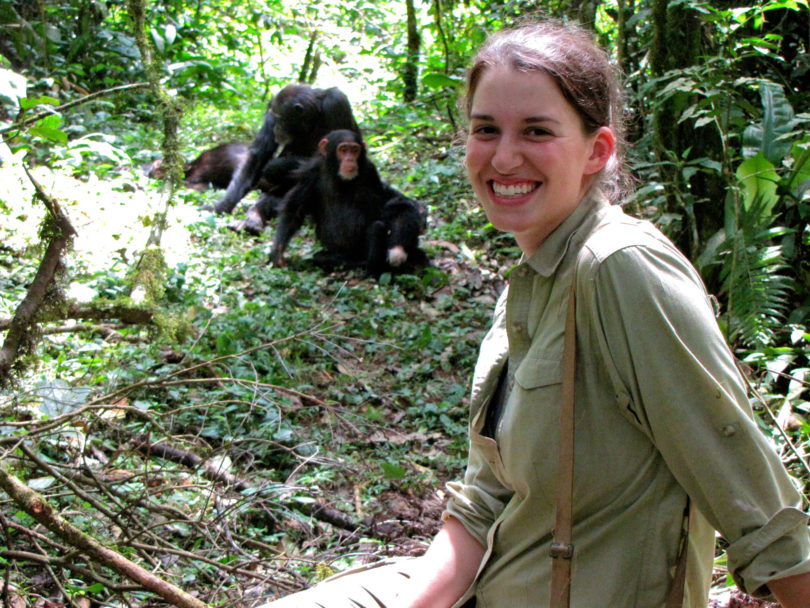Athens, Ga. – Vaccines are available for many infectious diseases that threaten endangered great ape populations, but immunizing enough animals to prevent outbreaks can be logistically challenging.
According to a study led by Julie Rushmore of the University of Georgia, focusing vaccination efforts on chimpanzees with the highest numbers of social contacts can reduce the number of animals that must be vaccinated to prevent an epidemic. This could ultimately make vaccination a more useful tool for the conservation of endangered great apes.
The research was published online in the Journal of the Royal Society Interface and focuses on the continuing research of Rushmore and her colleagues.
Rushmore, a student in the UGA College of Veterinary Medicine’s DVM/PhD program who completed her doctorate in the Odum School of Ecology in 2013, spent nearly a year observing the wild Kanyawara chimpanzee community in Kibale National Park, Uganda. She recorded the behavior of 37 chimpanzees in the community—including adults and juveniles of both sexes—and, along with her colleagues, used social network analysis to quantify which members of the community were more likely to contract and spread diseases based on how frequently they interacted with each other.
The most connected animals in the network tended to be high-ranking mothers and juveniles from large families; the high-ranking males were second in their centrality to the community.
The research team used mathematical models to simulate the spread and control of close-contact pathogens that have threatened wild apes in the recent past—like Ebola, measles and influenza—on the chimpanzee social networks derived from field behavioral data. The computer simulations showed that targeting the most connected chimpanzees could prevent large outbreaks with considerably fewer vaccines than would be required if vaccinations were randomly distributed.
Because it is often easier to record traits like gender and family size for a chimpanzee than to determine the animal’s connectivity in the social network, the research team also evaluated the effectiveness of targeting risk groups, such as high-ranking moms, for disease control. Vaccinating individuals with high-risk traits also proved to be more effective than randomly vaccinating individuals in the community.
Beyond the logistical challenges of administering vaccines, immunizing wildlife can be expensive and stressful to the animals, thus underscoring the need to reduce coverage when mobilizing vaccines for deadly pathogens.
“This work is important because it indicates that we can use what we know about animal behavior to design more efficient disease control strategies,” Rushmore said. “In addition to wild chimpanzees, the methods we used to evaluate targeted vaccinations could aid in conservation efforts for other endangered wildlife species that are vulnerable to infectious disease.”
Rushmore’s approach to disease control and prevention also could be applied to controlling disease in human populations.
“Julie’s work on chimpanzees is indicative of a new strategy for studying disease that combines field observation, infectious diseases information and computer modeling,” said John Gittleman, dean of the Odum School. “It is compelling because her approach will allow preventive measures against disease outbreak and likely apply to human emerging diseases.”
“Dr. Rushmore’s findings will influence the strategies used to control infectious disease transmission among vulnerable populations of animals and humans where vaccination of all susceptible individuals is simply not practical,” added Sheila W. Allen, dean of the College of Veterinary Medicine. “This is an excellent example of One Health-where findings in animal disease investigations inform the approach to be used in human disease control.”
The study by Rushmore and her colleagues on “Network-based Vaccination Improves Prospects for Disease Control in Wild Chimpanzees” is available at http://rsif.royalsocietypublishing.org/content/11/97/20140349.short?rss=1.
Rushmore’s co-authors were Damien Caillaud of the Dian Fossey Gorilla Fund International and a post-doctoral associate in the Section of Integrative Biology at the University of Texas at Austin; Richard J. Hall, an assistant research scientist in the UGA Odum School of Ecology; Rebecca M. Stumpf, an associate professor in the department of anthropology at the University of Illinois at Urbana-Champaign; Lauren Ancel Meyers, a professor in the Section of Integrative Biology at the University of Texas at Austin; and Sonia Altizer, a professor and associate dean of academic affairs in the UGA Odum School of Ecology.
UGA Odum School of Ecology
The UGA Odum School of Ecology, the world’s first stand-alone school dedicated to ecology, is creating the future of ecological discovery through innovative research about the rapidly changing planet, educating the next generation of ecologists and applying knowledge in service to the broader public. For more information, see www.ecology.uga.edu.
UGA College of Veterinary Medicine
The College of Veterinary Medicine, founded in 1946 at UGA, is dedicated to training future veterinarians, conducting research related to animal and human diseases and providing veterinary services for animals and their owners. Research efforts are aimed at enhancing the quality of life for animals and people, improving the productivity of poultry and livestock and preserving a healthy interface between wildlife and people in the environment they share. The college enrolls 114 students each fall out of more than 900 who apply. For more information, see www.vet.uga.edu.







